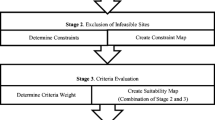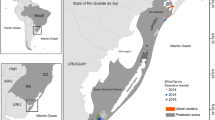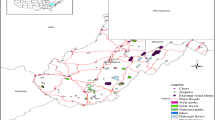Abstract
This paper focuses on the combined use of geographical information systems and multi-criteria decision methods when developing a decision support model in order to determine the most favourable sites for the installation of wind turbines on a regional scale. This study differs from others in three ways: (1) it analyses two distinct scenarios (depending on whether major or minor constraints, as defined in the existing literature, are applied); (2) the area under study, Cadiz, already has an extensive network of wind-generating facilities; and (3) this study analyses at length areas where installation is not suitable. The methodology is proven to be a valid and appropriate tool for identifying potential areas for wind-energy facilities on a regional scale for both planners and investors. The model is proved to be useful for planning and evaluating phases: for example, it helps to outline criteria which can be used to define sectors where the number of suitable areas for wind-energy facilities can be increased, as well as locations where repowering might be a suitable alternative.






Similar content being viewed by others
References
Al-Shabeeb AR, Al-Adamat R, Mashagbah A (2016) AHP with GIS for a preliminary site selection of wind turbines in the North West of Jordan. Int J Geosci 7:1208–1221. https://doi.org/10.4236/ijg.2016.710090
Al-Yahyai S, Charabi Y, Gastli A, Al-Badi A (2012) Wind farm land suitability indexing using multi-criteria analysis. Renew Energy 44:80–87. https://doi.org/10.1016/j.renene.2012.01.004
Angelis-Dimakis A, Biberacher M, Dominguez J et al (2011) Methods and tools to evaluate the availability of renewable energy sources. Renew Sustain Energy Rev 15(2):1182–1200. https://doi.org/10.1016/j.rser.2010.09.049
Aydin NY (2009) GIS-based site selection approach for wind and solar energy systems: a case study from western Turkey. Dissertation. Middle East Technical University
Aydin NY, Kentel E, Duzgun S (2010) GIS-based environmental assessment of wind energy systems for spatial planning: a case study from Western Turkey. Renew Sustain Energy Rev 14:364–373. https://doi.org/10.1016/j.rser.2009.07.023
Baban SMJ, Parry T (2001) Developing and applying a GIS-assisted approach to locating wind farms in the UK. Renew Energy 24(1):59–71
Baris KB, Bahadir S, Ulucan A, Umur M (2015) A GIS-based multiple criteria decision analysis approach for wind power plant site selection. Util Policies 3:86–96. https://doi.org/10.1016/j.jup.2015.06.001
Bergström H, Alfredsson H, Arnqvist J et al (2013) Wind power in forests winds an effects on loads. Elforsk rapport 13:09. Stockholm
Busby R (2012) Wind power. The industry grows up. Penn Well Corporation, Oklahoma
Choudhary D, Shankar R (2012) An STEEP-fuzzy AHP-TOPSIS framework for evaluation and selection of thermal power plant location: a case study from India. Energy 42(1):510–521. https://doi.org/10.1016/j.energy.2012.03.010
Colmenar-Santos A, Campíñez-Romero S, Pérez-Molina C, Mur-Pérez F (2015) Repowering: an actual possibility for wind energy in Spain in a new scenario without feed-in-tariffs. Renew Sustain Energy Rev 41:319–337. https://doi.org/10.1016/j.rser.2014.08.041
Council of Europe (2000) Convenio europeo del paisaje. Florencia: 20 de noviembre de 2000. http://conventions.coe.int/treaty/fr/Treaties/Html/176.html. Accessed 31 Jan 2018
de Lucas M, Janss GFE, Ferrer M (2007) Birds and wind farms: risk assessment and mitigation. Editorial Quercus, Madrid
Díaz-Cuevas P (2013) Energía eólica y territorio. Potencialidades para la implantación de parques eólicos en Andalucía. Dissertation. University of Seville
Díaz-Cuevas P, Fernández A, Pita MF (2016) Energía eólica y paisaje. Identificación y cuantificación de paisajes afectados por instalaciones eólicas en Andalucía. B Asoc Geogr Esp 71:397–430
Domínguez J, Amador J (2007) Geographical information systems applied in the field of the renewable energy sources. Comput Ind Eng 52:322–336. https://doi.org/10.1016/j.cie.2006.12.008
Domínguez-Bravo J (2002) La integración económica y territorial de las energías renovables y los sistemas de información geográfica. Dissertation. Universidad Complutense de Madrid
(EC) European Commission (2001) Communication from the commission on the precautionary principle. COM (2000) 1 final, Brussels
(EC) European Commission (2007a) An energy policy for Europe. COM (2007)1 final, Brussels
(EC) European Commission (2007b) Limiting global climate change to 2 C—the way ahead for 2020 and beyond. COM (2007) 2 final, Brussels
(EC) European Commission (2010) Europe 2020. A strategy for smart, sustainable and inclusive growth.COM (2010) 2020, Brussels
(EC) European Commission (2011a) A roadmap for moving to a competitive low carbon economy in 2050. COM (2011) 112 final, Brussels
(EC) European Commission (2011b) Energy roadmap 2050.COM (2011) 0885 final, Brussels
(EC) European Commission (2011c) White paper roadmap to a single European transport area—towards a competitive and resource efficient transport system COM (2011) 0144 final, Brussels
Effat AH (2014) Spatial modeling of optimum zones for wind farms using remote sensing and geographic information system, application in the Red Sea, Egypt. JGIS 6:358–374. https://doi.org/10.4236/jgis.2014.64032
Gorsevski PV, Cathcart S, Mirzaei G et al (2013) A group-based spatial decision support system for wind farm site selection in Northwest Ohio. Energy Policy 55:374–385. https://doi.org/10.1016/j.enpol.2012.12.013
Hansen HS (2005) GIS-based multi-criteria analysis of wind farm development. In: Hauska H, Tveite H (eds) ScanGIS’ 2005: proceedings of the 10th Scandinavian research conference on geographical information sciences, Stockholm, pp 75–87
Höfer T, Sunak Y, Siddique H, Madlener R (2014) Wind farm siting using a spatial analytic hierarchy process approach: a case study of the Städteregion Aachen, FCN Working Paper No. 16/2014, Institute for Future Energy Consumer Needs and Behavior, RWTH Aachen University
Hughes T (2000) Calculation of wind energy and power. Lesson number 2 in an Oklahoma Wind Power Tutorial Series
Izquierdo JM (2008) Energía eólica y territorio. Universidad de Sevilla y Consejería Obras Públicas y Transportes, Sevilla
Janke JR (2010) Multicriteria GIS modeling of wind and solar farms in Colorado. Renew Energy 35:2228–2234. https://doi.org/10.1016/j.renene.2010.03.014
Kumar A, Sah B, Singh A et al (2017) A review of multi criteria decision making (MCDM) towards sustainable renewable energy development. Renew Sustain Energy Rev 69:596–609. https://doi.org/10.1016/j.rser.2016.11.191
Latinopoulos D, Kechagia K (2015) A GIS-based Multi-criteria evaluation for wind farm site selection. A regional scale application in Greece. Renew Energy 78:550–560. https://doi.org/10.1016/j.renene.2015.01.041
Lejeune P, Feltz C (2008) Development of a decision support system of setting up a wind energy policy across the Walloon Region (southern Belgium). Renew Energy 33:2416–2422. https://doi.org/10.1016/j.renene.2008.02.011
Ley 2/1989, de 18 de Julio, por la que se aprueba el Inventario de Espacios Naturales Protegidos de Andalucía, y se establecen medidas adicionales para su protección. Boletín Oficial de la Junta de Andalucía, 60, p 3367
Ley 4/1989, de 27 de marzo, de Conservación de los Espacios Naturales y de la Flora y Fauna Silvestre. Boletín Oficial del Estado, 74, p 8262 a 8269
Ley 8/2001, de 12 de julio, de carreteras de Andalucía. Boletín Oficial Junta de Andalucía, 85 pp 12.799
Ley 9/2006, de 26 de diciembre, de Servicios Ferroviarios de Andalucía. Boletín Oficial Junta de Andalucía, 251, pp 3
Lorente-Plazas R, Montávez JP, Jerez JJ et al (2012) EOLMAP: a web tool to assess the wind resource over Spain. RE&PQJ 1(10):1264–1269
Manwell JF, McGowan JG, Rogers AL (2009) Wind energy explained: theory, design and application, 2nd edn. Wiley, Chichester
Miller A, Li R (2014) A geospatial approach for prioritizing wind farm development in Northeast Nebraska, USA. Int J Geo-Inf 3:968–979. https://doi.org/10.3390/ijgi3030968
Noorollahi Y, Youseffi H, Mohammadi M (2016) Multi-criteria decision support system for wind farm site selection using GIS. Sustain Energy Technol Assess 13:38–50. https://doi.org/10.1016/j.seta.2015.11.007
Panagiotidou M, Xydis G, Koroneos C (2016) Environmental siting framework for wind farms: a case study in the Dodecanese Islands. Resources 5(3):1–25. https://doi.org/10.3390/resources5030024
Patel MR (1999) Wind and solar power systems: design, analysis and operation. Taylor and Francis, New York
Prados MJ (2010) Renewable energy policy and landscape management in Andalusia, Spain: the facts. Energy Policy 8(11):6900–6909. https://doi.org/10.1016/j.enpol.2010.07.005
Bennui A, Rattanamanee P, Puetpaiboon, U, Phukpattaranont P, Chetpattananondh K (2007) Site selection for large wind turbines using GIS. In: PSU-UNS international conference on engineering and environment-ICEE-, Phuket, May 10–11
Ramírez-Rosado IJ, García-Garrido L, Fernández-Jiménez A et al (2008) Promotion of new wind farms based on a decision support system. Renewabl Energ 33:558–566. https://doi.org/10.1016/j.renene.2007.03.028
Resch B, Sagl G, Törnros T et al (2014) GIS-based planning and modeling for renewable energy: challenges and future research avenues. Int J Geo-Inf 3:662–692. https://doi.org/10.3390/ijgi3020662
Rodman L, Meentemeyer R (2006) A geographic analysis of wind turbine placement in Northern California. Energy Policy 34:2137–2149. https://doi.org/10.1016/j.enpol.2005.03.004
Saaty TL (1980) The analytic hierarchy process. Mc Grawhill, New York
Saaty TL (1989) Group decision making and the AHP. Springer, New York
Sadegui M, Karimi M (2017) GIS-based solar and wind turbine site selection using multi-criteria analysis: case study Tehran, Iran. The International Archives of the Photogrammetry, Remote Sensing and Spatial Information Sciences, Volume XLII-4/W4
Sánchez-Lozano JM, García-Cascales MS, Lamat MT (2014) Identification and selection of potential sites for onshore wind farms development in Region of Murcia, Spain. Energy 73:311–324. https://doi.org/10.1016/j.energy.2014.06.024
Sánchez-Lozano JM, García-Cascales MS, Lamata MT (2016) GIS-based onshore wind farm site selection using fuzzy multi-criteria decision making methods. Evaluating the case of Southeastern Spain. Appl Energy 17:86–102. https://doi.org/10.1016/j.apenergy.2016.03.030
Satking M, Noorollahi Y, Abbaspour M, Yousefi H (2014) Multi-criteria site selection model for wind-compressed air energy storage power plants. Renew Sustain Energy Rev 32:579–590. https://doi.org/10.1016/j.rser.2014.01.054
Schallenberg- Rodríguez J, Notario-del Pino J (2014) Evaluation of on-shore wind techno-economical potential in regions and islands. Appl Energy 124:117–129. https://doi.org/10.1016/j.apenergy.2014.02.050
Sliz-Szkliniarz B, Vogt J (2011) GIS-based approach for the evaluation of wind energy potential: a case study for the Kujawsko-Pomorskie Voivodeship. Renew Sustain Energy Rev 15:1696–1707. https://doi.org/10.1016/j.rser.2010.11.045
Söder L, Ackermann T (2012) Wind power in power systems: an introduction. In: Ackermann T (ed) Wind power in power systems, 2nd edn. Wiley, Chichester. https://doi.org/10.1002/9781119941842.ch4
Sunak Y, Höfer T, Siddique H et al (2015) A GIS-based decision support system for the optimal siting of wind farm projects. E.ON Energy Research Center Series and RWTH Aachen University, Aachen
Szurek M, Blachowski J, Nowaka A (2014) GIS-based method for wind farm location multi-criteria analysisis. Min Sci 21:65–85. https://doi.org/10.5277/ms142106
Tegou L, Polatidis H, Haralambopoulos DA (2010) Environmental management framework for wind farm siting: methodology and case study. J Environ Manag 91:2134–2147. https://doi.org/10.1016/j.jenvman.2010.05.010
Uyan M (2017) Optimal site selection for solar plants using multi-criteria ecaluation: a case of study from the region in Karaman, Turkey. Clean Technol Environ Policy 19:2231–2244. https://doi.org/10.1007/s1009
van Haaren R, Fthenakis V (2011) GIS-based wind farm site selection using spatial multi-criteria analysis (SMCA): evaluating the case for New York State. Renew Sustain Energy Rev 15:3332–3340. https://doi.org/10.1016/j.rser.2011.04.010
Villacreses G, Gaona G, Martínez-Gómez J, Juan D (2017) Wind farms suitability location using geographical information system (GIS), based on multi-criteria decision making (MCDM) methods: the case of continental Ecuador. Renew Energy 109:275–286. https://doi.org/10.1016/j.renene.2017.03.041
Voivontas D, Assimacopolous A, Corominas Mourelatos J (1998) Evaluation of renewable energy potential using a GIS decision support system. Renew Energy 3(13):333–344. https://doi.org/10.1016/S0960-1481(98)00006-8
Voogd H (1983) Multicriteria evaluation for urban and regional planning. Taylor & Francis, London
Wu Y, Geng S (2014) Multi-criteria decision making on selection of solar wind hybrid power station location: a case of China. Energy Convers Manag 81:527–533. https://doi.org/10.1016/j.enconman.2014.02.056
Yazdani M, Chatterjee P, Kazimieras Zavadskas E, Streimikiene D (2018) A novel integrated decision making approach for the evaluation and selection of renewable energy technologies. Clean Technnol Environ Policy. https://doi.org/10.1007/s10098-018-1488-4
Yue CD, Wang SS (2006) GIS-based evaluation of multifarious local renewable energy sources: a case study of the Chigu area of southwestern Taiwan. Energy Policy 34:730–742. https://doi.org/10.1016/j.enpol.2004.07.003
Author information
Authors and Affiliations
Corresponding author
Rights and permissions
About this article
Cite this article
Díaz-Cuevas, P., Biberacher, M., Domínguez-Bravo, J. et al. Developing a wind energy potential map on a regional scale using GIS and multi-criteria decision methods: the case of Cadiz (south of Spain). Clean Techn Environ Policy 20, 1167–1183 (2018). https://doi.org/10.1007/s10098-018-1539-x
Received:
Accepted:
Published:
Issue Date:
DOI: https://doi.org/10.1007/s10098-018-1539-x




